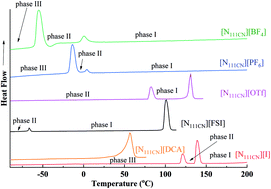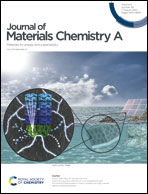Solid (cyanomethyl)trimethylammonium salts for electrochemically stable electrolytes for lithium metal batteries†
Abstract
Organic salts are being considered for the electrolyte solvent in rechargeable lithium-metal batteries (LMBs). This is due to their non-flammability, non-volatility, wide electrochemical window, good ionic conductivity and the possibility of operating while in a solid (or quasi-solid) state making them promising candidates to replace current flammable and toxic solvents present in conventional electrolytes. A series of novel solid cyano-ammonium salts with five different anions were synthesized by one-step anion metathesis. All salts were studied by thermogravimetric analysis (TGA), differential scanning calorimetry (DSC), electrochemical impedance spectroscopy (EIS) and Raman spectroscopy. Solid salts were obtained with [FSI]−, [BF4]−, [PF6]− and [OTf]− anions, while the [DCA]− containing salt was obtained as a low melting point solid. Comparison of the thermal and physical properties with analogous ammonium salts was made. The cyano-ammonium salts with [DCA]−, [FSI]−, [BF4]− and [PF6]− anions were studied by solid-state nuclear magnetic resonance spectroscopy (NMR). [N111CN][BF4] and [N111CN][FSI] were selected for mixing with lithium salts (10 and 50 mol% Li+) of the same anion. The four resultant electrolytes were studied by DSC and EIS. The 50 mol% LiFSI in [N111CN][FSI] was obtained as a liquid electrolyte and displayed an ionic conductivity of 3 × 10−3 S cm−1 at 50 °C with a lithium transference number of 0.37 ± 0.02 at 50 °C. The quasi-solid electrolyte 50 mol% LiBF4 in [N111CN][BF4] displayed an ionic conductivity of 0.78 × 10−3 S cm−1 at 90 °C with a transference number of 0.27 ± 0.02 at 90 °C. The electrochemical properties of these materials were investigated using linear sweep voltammetry (LSV) in addition to coin cell testing using various cell configurations. LSV measurements showed high oxidative stability up to 5.6 V (vs. Li+/Li), while Li metal symmetric cell cycling and Li|Cu coulombic efficiency (CE) measurements demonstrated the stable cycling of lithium metal with a CE of 91 ± 1% at 50 °C. Finally, preliminary results showing the applicability of these electrolytes to full cell devices were obtained using Li|NMC622 cells with a moderate areal capacity of 1.0 mA h cm−2, whereby full capacity cycling for 15 cycles at a rate of C/2 at 50 °C was achieved.



 Please wait while we load your content...
Please wait while we load your content...